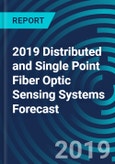The distributed fibre optic sensor market report has been expanded to cover single point sensors and extended to 2023. The distributed fibre optic sensor market stood at $651 million in 2014 with 49% associated with the oil and gas market segment. The overall market contracted through 2016 due to the fall in oil prices. Modest recovery occurred in 2017 until late 2018. Then another oil price drop has impacted the market. By 2023, the forecast shows the oil and gas market segment will increase in value, but due to growth in other segments, it will decrease to 19% of the distributed fibre optic sensor market.
The total distributed fibre optic sensor market that was projected (January 2017) to be $1,008 million in 2021 is now projected to be $821 million in 2021 reaching $1,033 in 2023.
The point sensor market is dominated by the fibre optic gyroscope market segment which is very dependent upon government spending. From 2013-2015 reductions in government spending impacted the market. From 2016, an up-turn in government spending has had a positive effect on growth. As fibre optic sensors become more cost-effective and technology advances, the industrial and medical markets will expand for point fibre optic sensors.
The combined distributed and single point fibre optic sensor markets are projected to be over $1.3 billion in 2023 according to an updated and expanded market survey report conducted by the Photonic Sensor Consortium and published by the author.
The expanded report provides much greater detail for how the market is forecasted for specific technologies. Data is provided in graphic and tabular formats. The market is broken down for DTS, Bragg grating, DAS, interferometric and Brillouin scattering technologies in relation to the various market segment applications (oil and gas, military, homeland security, smart structures, etc.). In addition, the three dominant technologies (DTS, DAS, and Bragg gratings) show relative market share by the major suppliers.
Distributed fibre optic sensors are an enabling technology that creates smart systems in a variety of applications. The initial commercialization efforts focused on military applications. However, the need to function in harsh environments and the development of optical fibre technology that can survive in these applications has significantly impacted the oil and gas industry. These smart sensing systems provide benefits throughout the life of a well from exploration to drilling and completion, production and reservoir management. There is no other technology that can provide critical process control information spatially throughout the well in real-time over long periods. Without smart well technology, fracking monitoring and analysis and applications like steam-assisted gravity drainage (SAGD) would be very difficult to implement effectively. Fibre optic sensors are proven technology and applications are expanding over multiple markets.
In a manner similar to the distributed fibre optic sensor forecast, the point fibre optic sensor market is broken down by market segments and by specific technologies.
There are several characteristic advantages of fibre optics that make their use especially attractive for sensors:
- Nonelectrical
- Explosion-proof
- Small size and weight
- Allow access into normally inaccessible areas and harsh environments
- Immune to radio frequency interference (RFI) and electromagnetic interference (EMI)
- Solid-state reliability
- High accuracy
- Can facilitate distributed sensing
Most physical properties can be sensed optically with fibres. Light intensity, displacement (position), temperature, pressure, rotation, sound, strain, magnetic field, electric field, radiation, flow, liquid level, chemical analysis, and vibration are just some of the phenomena that can be sensed.
Fibre optic sensors have been used successfully for many years in military gyroscopes and hydrophones. However, their use in smart oil wells has been the key to enabling North America to be on a path to energy independence.
Table of Contents
1. Reason for Update2. Photonic Sensor Consortium Background
Companies Mentioned
- 4DSP
- AP Sensing
- Baker Hughes
- CGGVeritas
- CiDRA (Fiber optic sensor business)
- FAZ Technologies
- FBGS
- FISO Technologies
- Fiber SenSys
- Fibersonics
- Fotech
- Fugro Geoscience Division
- Halliburton
- IFOS
- IXBlue
- Insensys (Renewable Energy)
- Insensys Oil & Gas
- Intelligent Optical Systems
- LIOS Technology
- Luna
- Luna Energy
- LxData
- Micron Optics
- Moog (Insensys)
- NP Photonics
- Northrop Grumman
- OZ Optics
- Opsens
- Optasense (QinetiQ)
- Optiphase
- Optoplan
- PGS
- Petrospec Engineering
- QinetiQ
- Qorex
- Schlumberger
- Sensa
- Sensornet
- Silixa
- Smart Fibre
- Smartec (Roctest Group)
- Stingray
- TGS
- US Seismic Systems, Inc. (USSI)
- WavefieldInseis
- Weatherford
- Welldog
- Zeibel








